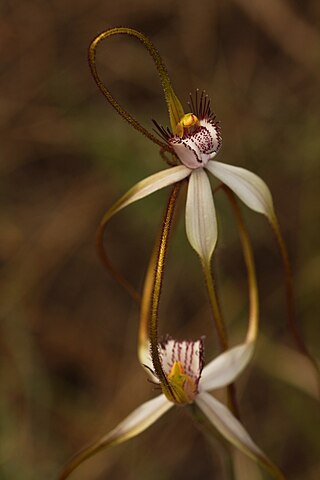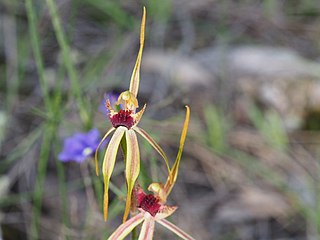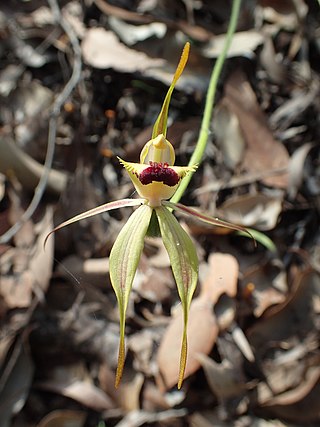
Caladenia plicata, commonly known as the crab-lipped spider orchid, is a species of orchid endemic to the south-west of Western Australia. It has a single hairy leaf and one or two red, yellow and pale green flowers with an unusual labellum which vibrates in the slightest breeze.

Caladenia longicauda subspecies borealis, commonly known as daddy-long-legs spider orchid, is a plant in the orchid family Orchidaceae and is endemic to the south-west of Western Australia. It has a single hairy leaf and up to three mostly white flowers with long, drooping sepals and petals.

Caladenia falcata, commonly known as the fringed mantis orchid, is a species of orchid endemic to the south-west of Western Australia. It is a relatively common orchid within its natural range and has a single, hairy leaf and one or two green, yellow and red flowers with spreading petals and upswept lateral sepals.

Caladenia fluvialis, commonly known as the Brookton Highway spider orchid, is a species of orchid endemic to the south-west of Western Australia. It is a recently discovered orchid with a single hairy leaf and one or two cream-yellow flowers with red markings on the labellum.

Caladenia gardneri, commonly known as the cherry spider orchid, is a species of orchid endemic to the south-west of Western Australia. It has a single, hairy leaf and up to three pale pink, sweetly scented flowers with a dark pinkish-red labellum.

Caladenia applanata subsp. applanata, commonly known as the broad-lipped spider orchid, is a species of orchid endemic to the south-west of Western Australia. It is a relatively common orchid with a single erect, hairy leaf and up to three flowers which may be red, cream, green or yellow and have a broad, flattened, red-tipped labellum.

Caladenia longicauda subsp. rigidula, commonly known as the rigid white spider orchid or island white spider orchid, is a plant in the orchid family Orchidaceae and is endemic to the south-west of Western Australia. It has a single hairy leaf and up to three large, mainly white flowers with relatively short lateral sepals and petals. It is similar to the reclining white spider orchid but that species has smaller, cream-coloured flowers.

Caladenia longiclavata, commonly known as the clubbed spider orchid, is a species of plant in the orchid family, Orchidaceae and is endemic to the south-west of Western Australia. It is a widespread and common orchid with a single, hairy leaf and one or two greenish-yellow, white and red flowers and which grows in the area between Perth and Albany.

Caladenia magniclavata, commonly known as big clubbed spider orchid, is a species of orchid endemic to the south-west of Western Australia. It has a single, hairy leaf, and up to three pale yellow-green and red flowers with downswept, prominently clubbed sepals and petals.

Caladenia microchila, commonly known as the western wispy spider orchid, is a species of orchid endemic to the south-west of Western Australia. It is relatively common orchid with a single erect, hairy leaf and up to three wispy white flowers with narrow lateral sepals and petals and a white labellum with red markings.

Caladenia pendens subsp. pendens, commonly known as the pendant spider orchid, is a plant in the orchid family Orchidaceae and is endemic to the south-west of Western Australia. It has a single hairy leaf and up to three relatively large, creamy-white flowers with long drooping petals and sepals and sometimes has a sickly-sweet scent.

Caladenia pendens subsp. talbotii, commonly known as Talbot's spider orchid, is a plant in the orchid family Orchidaceae and is endemic to the south-west of Western Australia. It has a single hairy leaf and one or two white, red and yellow flowers with long drooping petals and sepals and sometimes has a citrus-like scent.
Caladenia perangusta, commonly known as the Boyup Brook spider orchid, is a species of orchid endemic to the south-west of Western Australia. It is a rare spider orchid with a single hairy leaf and one or two cream-yellow or red flowers with narrow, drooping sepals and petals.
Caladenia pholcoidea subsp. pholcoidea, commonly known as the Albany spider orchid, is a plant in the orchid family Orchidaceae and is endemic to the south-west of Western Australia. It has a single hairy leaf and up to four pale yellow flowers with long drooping petals and lateral sepals.
Caladenia pholcoidea subsp. augustensis, commonly known as the Augustus spider orchid, is a plant in the orchid family Orchidaceae and is endemic to the south-west of Western Australia. It is a rare orchid with a single hairy leaf and up to three mostly white flowers with long spreading petals and lateral sepals.

Caladenia radiata, commonly known as the ray spider orchid, is a species of orchid endemic to the south-west of Western Australia. It has a single erect, hairy leaf and one or two green, yellow and red flowers. It flowers more profusely after fire and grows in swampy areas, sometimes flowering whilst in water.

Caladenia rhomboidiformis, commonly known as the diamond spider orchid, is a species of orchid endemic to the south-west of Western Australia. It has a single erect, hairy leaf and one or two green, yellow and red flowers. Until 1971 It was known as a variety of the green comb spider orchid Caladenia dilatata then, until 1989 as a variety of the clubbed spider orchid, Caladenia longiclavata.

Caladenia petrensis, commonly known as the rock spider orchid, is a species of plant in the orchid family Orchidaceae and is endemic to the south-west of Western Australia. It has a single erect, hairy leaf and up to three pale yellow flowers with drooping lateral sepals and petals.

Caladenia saxicola, commonly known as the banded ironstone spider orchid, is a species of plant in the orchid family Orchidaceae and is endemic to the south-west of Western Australia. It has a single erect, hairy leaf and one or two dull creamy-white to pale yellow flowers with spreading lateral sepals and petals.

Caladenia straminichila, commonly known as the Tenterden yellow spider orchid, is a species of orchid endemic to the south-west of Western Australia. It has a single erect, hairy leaf and one or two pale yellow flowers which have a red-striped labellum with short teeth on its sides.


















